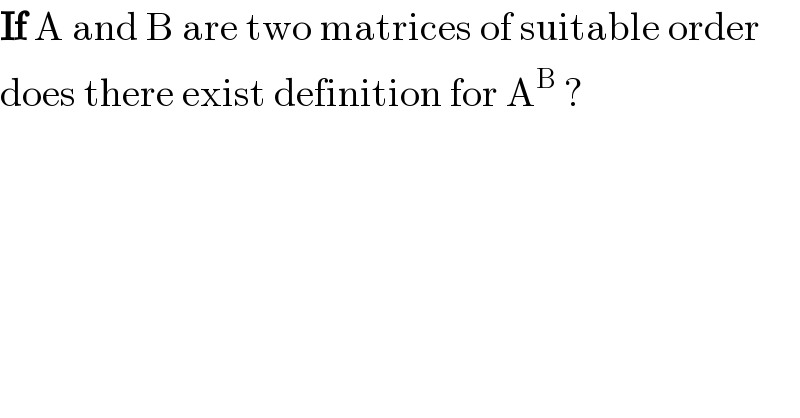Question Number 2546 by Rasheed Soomro last updated on 22/Nov/15

$$\boldsymbol{\mathrm{If}}\:\mathrm{A}\:\mathrm{and}\:\mathrm{B}\:\mathrm{are}\:\mathrm{two}\:\mathrm{matrices}\:\mathrm{of}\:\mathrm{suitable}\:\mathrm{order} \\ $$$$\mathrm{does}\:\mathrm{there}\:\mathrm{exist}\:\mathrm{definition}\:\mathrm{for}\:\mathrm{A}^{\mathrm{B}} \:? \\ $$
Commented by Yozzi last updated on 22/Nov/15
![A^B =e^((lnA)B) if A and B are sqaure and non−singular. e^((lnA)B) =1+(lnA)B+((((lnA)B)^2 )/(2!))+((((lnA)B)^3 )/(3!))+... ∴ A^B =Σ_(r=0) ^∞ (1/(r!))[(lnA)B]^(r ) (Matrix exponential)](https://www.tinkutara.com/question/Q2553.png)
$${A}^{{B}} ={e}^{\left({lnA}\right){B}} \:\:{if}\:{A}\:{and}\:{B}\:{are}\:{sqaure} \\ $$$${and}\:{non}−{singular}. \\ $$$${e}^{\left({lnA}\right){B}} =\mathrm{1}+\left({lnA}\right){B}+\frac{\left(\left({lnA}\right){B}\right)^{\mathrm{2}} }{\mathrm{2}!}+\frac{\left(\left({lnA}\right){B}\right)^{\mathrm{3}} }{\mathrm{3}!}+… \\ $$$$\therefore\:{A}^{{B}} =\underset{{r}=\mathrm{0}} {\overset{\infty} {\sum}}\frac{\mathrm{1}}{{r}!}\left[\left({lnA}\right){B}\right]^{{r}\:} \:\:\:\:\left({Matrix}\:{exponential}\right) \\ $$
Commented by Rasheed Soomro last updated on 22/Nov/15

$$\mathcal{TH}{an}\mathfrak{K}\mathcal{S}\:{for}\:\mathcal{S}{haring}\:\mathcal{K}{nowledge}.{One}\:{thing}\:{more} \\ $$$$\mathcal{I}\:{would}\:{like}\:{to}\:{ask}\:\underset{−} {{how}\:{lnA}\:{is}\:{defined}?} \\ $$$$\mathcal{D}{o}\:{A}\:{and}\:{B}\:{need}\:{to}\:{be}\:{of}\:{same}\:{order}? \\ $$
Commented by Yozzi last updated on 22/Nov/15
. Then lnA^′ = [((lna 0)),((0 lnb)) ]. Taking ln on both sides of (∗) lnA^′ =V^(−1) (lnA)V⇒lnA=V(lnA^′ )V^(−1) .](https://www.tinkutara.com/question/Q2565.png)
$${If}\:{A}\:{can}\:{be}\:{diagonalised}, \\ $$$${to}\:{find}\:{lnA},\:{find}\:{the}\:{eigenvector}\: \\ $$$${matrix}\:{V}\:{of}\:{the}\:{matrix}\:{A}.\:{With} \\ $$$${A}^{'} \:{as}\:{a}\:{diaginal}\:{matrix}\:{of}\:{the} \\ $$$${eigenvalues}\:{of}\:{A}\:{for}\:{its}\:{corresponding} \\ $$$${V}\:{write}\:{A}^{'} ={V}^{−\mathrm{1}} {AV}\:\:\:\:\left(\ast\right){where}\:{V}^{−\mathrm{1}} \:{is}\:{the} \\ $$$${inverse}\:{matrix}\:{of}\:{V}.\:\: \\ $$$${Suppose}\:{A}^{'} =\begin{bmatrix}{{a}\:\:\:\mathrm{0}}\\{\mathrm{0}\:\:\:{b}}\end{bmatrix}\left({for}\:{example}\right). \\ $$$${Then}\:{lnA}^{'} =\begin{bmatrix}{{lna}\:\:\:\mathrm{0}}\\{\mathrm{0}\:\:\:\:{lnb}}\end{bmatrix}.\: \\ $$$${Taking}\:{ln}\:{on}\:{both}\:{sides}\:{of}\:\left(\ast\right) \\ $$$${lnA}^{'} ={V}^{−\mathrm{1}} \left({lnA}\right){V}\Rightarrow{lnA}={V}\left({lnA}^{'} \right){V}^{−\mathrm{1}} . \\ $$
Commented by Rasheed Soomro last updated on 22/Nov/15

$$\boldsymbol{\mathcal{THANK}}^{\mathcal{S}{sss}\:\:} \:! \\ $$
